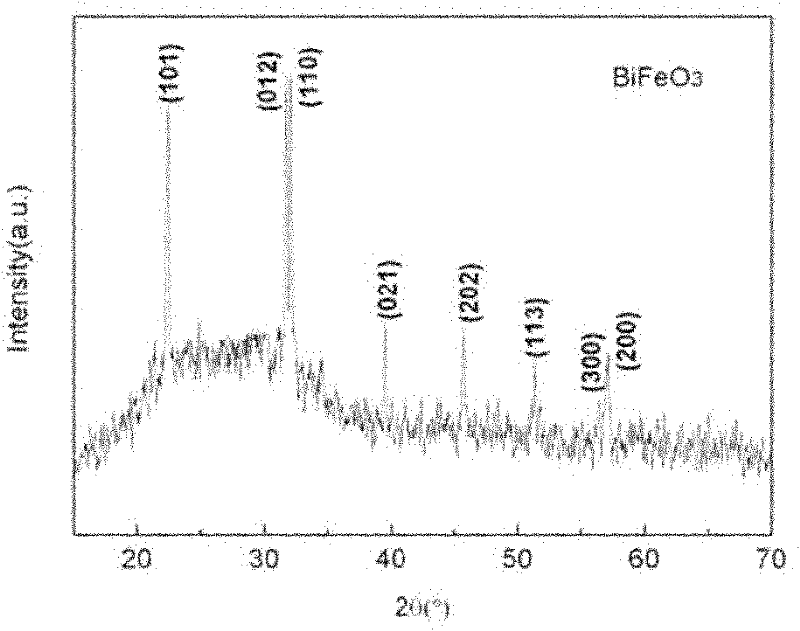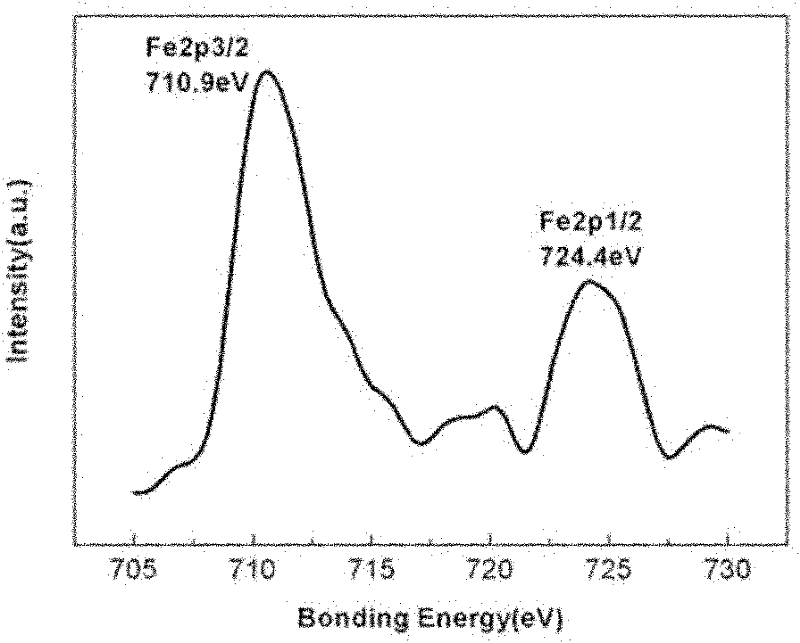Photoethcing self assembly preparation method of patterned BiFeO3 film
A patterning and self-assembly technology, applied in spin-exchange coupled multilayer films, substrate/intermediate layers, nanotechnology, etc., to achieve the effects of simple preparation process, clear edge outline, and broad application prospects
- Summary
- Abstract
- Description
- Claims
- Application Information
AI Technical Summary
Problems solved by technology
Method used
Image
Examples
Embodiment 1
[0030] (1) Choose a common glass slide as the base, cut the glass substrate into a rectangle of 20mm×10mm, and use commercially available detergent, acetone, and ethanol to ultrasonically clean it for 10 minutes to remove grease and other impurities on the surface of the glass substrate. After each ultrasonic cleaning, the substrates were rinsed with copious amounts of distilled water and finally dried with nitrogen gas. Place the clean substrate in a UV irradiator for 15 minutes to make the surface of the substrate reach "atomic cleanliness".
[0031] (2) Place the substrate irradiated by ultraviolet light in a newly prepared 1vol% octadecyltrichlorosilane (OTS)-toluene solution, and soak it for 30 minutes at room temperature to form a layer of OTS on the surface of the substrate. Monolayer. After soaking, wash with acetone for 2 min, blow dry with nitrogen, and then bake at 120 °C for 5 min to remove residual organic matter and promote chemical adsorption of OTS-SAMs. Then...
Embodiment 2
[0037] (1) Choose a common glass slide as the base, cut the glass substrate into a rectangle of 20mm×10mm, and use commercially available detergent, acetone, and ethanol to ultrasonically clean it for 10 minutes to remove grease and other impurities on the surface of the glass substrate. After each ultrasonic cleaning, the substrates were rinsed with copious amounts of distilled water and finally dried with nitrogen gas. Place the clean substrate in a UV irradiator for 10 minutes to make the surface of the substrate reach "atomic cleanliness".
[0038] (2) Place the substrate irradiated by ultraviolet light in a newly prepared 1vol% octadecyltrichlorosilane (OTS)-toluene solution, and soak it for 20 minutes at room temperature to form a layer of OTS on the surface of the substrate. Monolayer. After soaking, wash with acetone for 3 min, blow dry with nitrogen, and then bake at 110 °C for 4 min to remove residual organic matter and promote chemical adsorption of OTS-SAMs. Then...
Embodiment 3
[0042] (1) Choose a common glass slide as the base, cut the glass substrate into a rectangle of 20mm×10mm, and use commercially available detergent, acetone, and ethanol to ultrasonically clean it for 10 minutes to remove grease and other impurities on the surface of the glass substrate. After each ultrasonic cleaning, the substrates were rinsed with copious amounts of distilled water and finally dried with nitrogen gas. Place the clean substrate in a UV irradiator for 20 minutes to make the surface of the substrate reach "atomic cleanliness".
[0043] (2) Place the substrate irradiated by ultraviolet light in a newly prepared 1vol% octadecyltrichlorosilane (OTS)-toluene solution, and soak it for 40 minutes at room temperature to form a layer of OTS on the surface of the substrate. Monolayer. After soaking, wash with acetone for 3 min, blow dry with nitrogen, and then bake at 130 °C for 3 min to remove residual organic matter and promote chemical adsorption of OTS-SAMs. Then...
PUM
 Login to View More
Login to View More Abstract
Description
Claims
Application Information
 Login to View More
Login to View More - R&D
- Intellectual Property
- Life Sciences
- Materials
- Tech Scout
- Unparalleled Data Quality
- Higher Quality Content
- 60% Fewer Hallucinations
Browse by: Latest US Patents, China's latest patents, Technical Efficacy Thesaurus, Application Domain, Technology Topic, Popular Technical Reports.
© 2025 PatSnap. All rights reserved.Legal|Privacy policy|Modern Slavery Act Transparency Statement|Sitemap|About US| Contact US: help@patsnap.com



